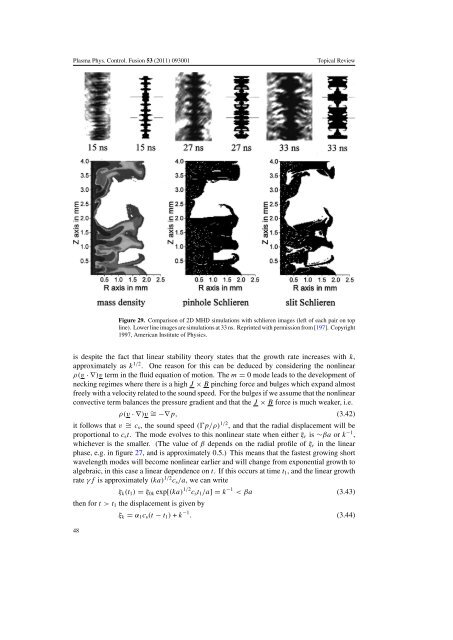Create successful ePaper yourself
Turn your PDF publications into a flip-book with our unique Google optimized e-Paper software.
Plasma Phys. Control. Fusion 53 (2011) 093001<br />
Topical Review<br />
Figure 29. Comparison <strong>of</strong> 2D MHD simulations with schlieren images (left <strong>of</strong> each pair on top<br />
line). Lower line images are simulations at 33 ns. Reprinted with permission from [197]. Copyright<br />
1997, American Institute <strong>of</strong> Physics.<br />
is despite <strong>the</strong> fact that linear stability <strong>the</strong>ory states that <strong>the</strong> growth rate increases with k,<br />
approximately as k 1/2 . One reason for this can be deduced by considering <strong>the</strong> nonlinear<br />
ρ(v ·∇)v term in <strong>the</strong> fluid equation <strong>of</strong> motion. The m = 0 mode leads to <strong>the</strong> development <strong>of</strong><br />
necking regimes where <strong>the</strong>re is a high J × B <strong>pinch</strong>ing force and bulges which expand almost<br />
freely with a velocity related to <strong>the</strong> sound speed. For <strong>the</strong> bulges if we assume that <strong>the</strong> nonlinear<br />
convective term balances <strong>the</strong> pressure gradient and that <strong>the</strong> J × B force is much weaker, i.e.<br />
ρ(v ·∇)v ∼ = −∇p, (3.42)<br />
it follows that v ∼ = cs , <strong>the</strong> sound speed (Ɣp/ρ) 1/2 , and that <strong>the</strong> radial displacement will be<br />
proportional to c s t. The mode evolves to this nonlinear state when ei<strong>the</strong>r ξ r is ∼βa or k −1 ,<br />
whichever is <strong>the</strong> smaller. (The value <strong>of</strong> β depends on <strong>the</strong> radial pr<strong>of</strong>ile <strong>of</strong> ξ r in <strong>the</strong> linear<br />
phase, e.g. in figure 27, and is approximately 0.5.) This means that <strong>the</strong> fastest growing short<br />
wavelength modes will become nonlinear earlier and will change from exponential growth to<br />
algebraic, in this case a linear dependence on t. If this occurs at time t 1 , and <strong>the</strong> linear growth<br />
rate γf is approximately (ka) 1/2 c s /a, we can write<br />
ξ k (t 1 ) = ξ 0k exp[(ka) 1/2 c s t 1 /a] = k −1 t 1 <strong>the</strong> displacement is given by<br />
ξ k = α 1 c s (t − t 1 ) + k −1 . (3.44)<br />
48














